
Nests & bird nesting boxes
Share
Now spring is well underway, garden birds are very busy building nests to lay their eggs and raise their family during the coming months. Different birds, however, make different types of nests.

For instance, blackbirds, thrushes, and robins take a lot of care and attention when building their open-fronted nests. Taking small twigs interwoven with grass they build a very neat compact nest and plaster it with mud to help hold it together, lining it with soft materials such as moss.
Greenfinches sometimes nest in small groups, in low trees or bushes around 1.5m to 5m high. The nest is very untidy and made up of thin twigs, moss, and dried grass. Often lined with feathers, hair, and roots – they have two broods between April and July, very occasionally three.
If you don’t have trees, outbuildings, or anything that a bird can make a natural nest in then there are many different types of commercial ready-made nest boxes available.
Putting up a nest box in your garden is a great idea both for the birds and you. From the very first sign of parent birds looking for a suitable home, to the laying of the eggs, to finally watching nestlings and fledglings taking their first steps in a big new world.

If you have gone to the trouble of putting up a nest box or if your local birds have built a nest in your garden then we become, or it certainly feels like it, surrogate parents. We guarantee you’ll become emotionally involved.
When it comes to siting your nest box then the ‘where’ is more important than ‘when’. Nest boxes should help to provide a safe comfortable home and protect the inhabitants from predators like cats and weather conditions.
Serious thought must be given to where to place your box. For many species the height is not crucial but by trying to put the box around two metres from the ground this can help prevent human interference and predators. Try placing the box out of prevailing winds and strong sunlight. In the UK this means a northerly, easterly, or south-easterly position is best.
The final thing to think about is to place the nest box where you and your family can view it. It’s so important to get the enjoyment of watching wild birds in your garden.
We are often asked how many nest boxes should be put up. The answer really does depend on the size of the habitat and species. The larger the area the more boxes you can put up. Even if you only have room for one box then it’s certainly worthwhile as many natural habitats are disappearing.
After a successful – we hope – breeding season a little after care should be given to the empty nest boxes. We would recommend only cleaning your boxes once a year. Autumn is the best month to do this job as right up until August your garden birds could be occupying the box.

When the time is right empty the box of any contents and clean out with boiling water. Remove debris from the corners with a small brush or scraper and leave the lid off for a while to dry out the inside. It goes without saying to wear gloves to carry out this task and try not to breathe in any dust from the box before cleaning it as this may contain parasites.
One piece of good advice is please do not wait until winter to clean out nest boxes as garden birds may already be roosting in them. Also nest boxes can become a great winter home for insects and bugs!
Haith’s have a great range of nest boxes to choose from. One of our favourites is the simple Roosting Pouch which offers shelter for smaller birds. Made from woven rice straw it will give warmth and shelter throughout the year. At a height of just 24cm it’s perfect for the smaller garden.
If you’re wanting something a little more substantial, then a traditional wooden nest box could be for you. The Cosy Bird Nest Box is designed to attract members of the tit family and tree sparrows. Constructed from responsibly managed timber it will give protection against all types of weather.

Robins don’t just use old boots or something similar to nest in, they will also use an Open Fronted Nest Box. These are made especially for robins and wrens and should be sited at least 1.5m above the ground.
Multi Nest Boxes are a great buy for a wide variety of different garden birds. They have an interchangeable front so you can choose which species to attract.
However and whichever way you choose to help nesting garden birds we hope these tips are of help and if you’ve missed this breeding season don’t worry! Spring comes around every year and will soon be here again.
Written by Angela

